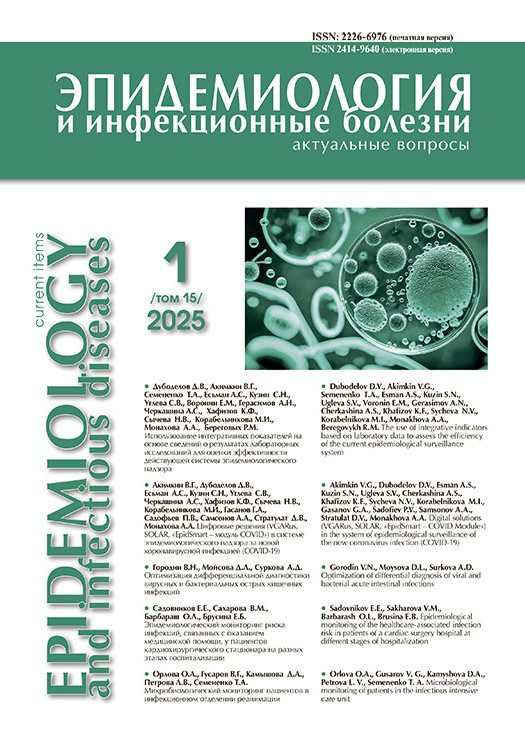Current epidemic situation of Q fever in Rostov Region
DOI: https://dx.doi.org/10.18565/epidem.2025.15.1.29-34
Sokirkina E.N., Noskov A.K., Kovalev E.V., Karpushchenko G.V., Pichurina N.L., Orekhov I.V., Evdokimova V.V., Simakova D.I., Vodopyanov A.S., Fedchenko A.V.
1) Rostov-on-Don Anti-Plague Research Institute, Federal Service for Surveillance on Consumer Rights Protection and Human Well-Вeing, Rostov-on-Don, Russia; 2) Office of the Federal Service for Surveillance on Consumer Rights Protection and Human Well-Вeing in the Rostov Region, Rostov-on-Don, Russia; 3) Center for Hygiene and Epidemiology in the Rostov Region, Rostov-on-Don, Russia; 4) Territorial Department of the Office of the Federal Service for Surveillance on Consumer Rights Protection and Human Wellbeing in the Rostov Region in the Salsky, Tselinsky, Peschanokopsky, Yegorlyksky, Orlovsky, Proletarsky (s) districts, Salsk, Russia
Materials and methods. The study was conducted by the method of epidemiological analysis using reporting data. Blood serum samples of people and farm animals, field material and environmental objects from anthropological (economic) foci were examined using modern laboratory methods.
Results. In 2022, 27 cases of Q fever were registered in 4 districts of the Rostov Region. The victims were mainly men of working age, residents of rural areas. Most patients were infected in anthropogenic foci formed in private subsidiary farms (PSF) and agricultural enterprises. During the epizootological survey conducted in natural biotopes, isolated finds of Coxiella burnetii were detected. In 28.6% of samples of material collected in anthropogenic foci, the pathogen DNA was detected. According to the results of studying the immune layer of the population of the Salsky and Remontnensky districts, the proportion of seropositive individuals was 3.0 and 1.3%, respectively. The pathogen was cultured on the Vero E6 cell line and a biological sample was set up. A culture of C. burnetii was isolated from the patient’s blood serum.
Conclusion. The current epidemic situation with Q fever in the Rostov Region is determined by periodically registered cases of human disease. Patients were identified in the southeast of the region in areas with a developed livestock farming structure. The epidemic process is caused by the formation of anthropogenic foci in private subsidiary farms and agricultural enterprises.
Literature
1. Лукин Е.П., Мищенко О.А., Борисевич С.В. Лихорадка Ку в XXI в.: материал для подготовки лекции. Инфекционные болезни: новости, мнения, обучение 2019; 8(4): 62–77. DOI: 10.24411/2305-3496-2019-14009 Lukin E.P., Mishchenko O.A., Borisevich S.V. [Q Fever: XXI Century (lecture material)]. Infectious Diseases: News, Opinions, Training 2019; 8(4): 62–77. (In Russ.). DOI: 10.24411/2305-3496-2019-14009 2. Яковлев Э.А., Борисевич С.В., Попова А.Ю., Ежлова Е.Б., Демина Ю.В. Заболеваемость лихорадкой Ку в Российской Федерации и странах Европы: реалии и проблемы. Проблемы особо опасных инфекций 2015; (4): 49–54. Yakovlev E.A., Borisevich S.V, Popova A.Yu., Ezhlova E.B., Demina Yu.V. [Morbidity Rates of Q Fever in the Russian Federation and European Countries: Realities and Problems]. Problems of Particularly Dangerous Infections 2015; (4): 49–54. (In Russ.). 3. Шпынов С.Н., Рудаков Н.В., Зеликман С.Ю. Анализ заболеваемости лихорадкой Ку в Российской Федерации в период с 1957 по 2019 год. Проблемы особо опасных инфекций 2021; (3): 141–146. DOI: 10.21055/0370-1069-2021-3-141-146 Shpynov S.N., Rudakov N.V., Zelikman S.Yu. [Analysis of Q Fever Incidence in the Russian Federation Between 1957 and 2019]. Problems of Particularly Dangerous Infections 2021; (3): 141–146. (In Russ.). DOI: https://doi.org/10.21055/0370-1069-2021-3-141-146 4. Здродовский П.Ф., Голиневич Е.М. Учение о риккетсиях и риккетсиозах. М.: Медицина, 1972. 495 с. Zdrodovsky P.F., Golinevich E.M. The doctrine of rickettsias and rickettsioses. M.: Medicine, 1972. 495 p. (In Russ.). 5. Дворцова И.В., Москвитина Э.А., Пичурина Н.Л., Орехов И.В., Сишко Т.В., Бабин М.А. и др. Лихорадка Ку: структурно-функциональная организация паразитарных систем природных и хозяйственных очагов, эпизоотологические и эпидемические проявления инфекции в Ростовской области. Пест-менеджмент 2018; (1): 11–17. Dvortsova I.V., Moskvitina E.A., Pichurina N.L., Orehov I.V., Sishko T.V., Babin M.A et al. [Q fever: the structural and functional organization of the parasitic systems in the natural and agricultural foci, the epizootological and epidemic manifestations of the infection in Rostov region]. Pest-management 2018; (1): 11–17 (in Russ.).
About the Autors
Elena N. Sokirkina, Junior Researcher, Rostov-on-Don Anti-Plague Research Institute, Russian Federal Service for Supervision of Consumer Rights Protection and Human Well-Being, Rostov-on-Don, Russia; sokirkina_en@antiplague.ru; https://orcid.org/0000-0002-4864-9576
Aleksey K. Noskov, Cand. Med. Sci, Director, Rostov-on-Don Anti-Plague Research Institute,, Russian Federal Service for Supervision of Consumer Rights Protection and Human Well-Being, Rostov-on-Don, Russia; plague@aaanet.ru; https://orcid.org/0000-0003-0550-2221
Еvgeny V. Kovalev, Head, Chief State Sanitary Doctor for the Rostov Region, Office of the Russian Federal Service for Supervision of Consumer Rights Protection and Human Well-Being in the Rostov Region, Rostov-on-Don, Russia; master@rpndon.ru; https://orcid.org/0000-0002-0840-4638
Garry V. Karpushchenko, Cand. Med. Sci, Сhief Physician, Center for Hygiene and Epidemiology in the Rostov Region, Rostov-on-Don, Russia; master@donses.ru; https://orcid.org/0000-0003-4672-8753
Natalia L. Pichurina, Cand. Med. Sci, Leading Researcher, Rostov-on-Don Anti-Plague Research Institute, Russian Federal Service for Supervision of Consumer Rights Protection and Human Well-Being, Rostov-on-Don, Russia; plague@aaanet.ru; https://orcid.org/0000-0003-1876-5397
Igor V. Orekhov, Cand. Biol. Sci, Senior Researcher, Rostov-on-Don Anti-Plague Research Institute, Russian Federal Service for Supervision of Consumer Rights Protection and Human Well-Being, Rostov-on-Don, Russia; plague@aaanet.ru; https://orcid.org/0000-0001-7404-4792
Veronika V. Evdokimova, Cand. Biol. Sci, Researcher, Rostov-on-Don Anti-Plague Research Institute, Russian Federal Service for Supervision of Consumer Rights Protection and Human Well-Being, Rostov-on-Don, Russia; plague@aaanet.ru; https://orcid.org/0000-0001-5522-9097
Diana I. Simakova, Cand. Biol. Sci, Senior Researcher, Rostov-on-Don Anti-Plague Research Institute, Russian Federal Service for Supervision of Consumer Rights Protection and Human Well-Being, Rostov-on-Don, Russia; plague@aaanet.ru; https://orcid.org/0000-0001-5598-5271
Alexey S. Vodopyanov, Cand. Med. Sci, Leading Researcher, Rostov-on-Don Anti-Plague Research Institute, Russian Federal Service for Supervision of Consumer Rights Protection and Human Well-Being, Rostov-on-Don, Russia; vodopyanov_as@antiplague.ru; https://orcid.org/0000-0002-9056-3231
Antonina V. Fedchenko, Head, Territorial Department of the Office of the Russian Federal Service for Supervision of Consumer Rights Protection and Human Well-Being for the Rostov Region in Salsky, Tselinsky, Peschanokopsky, Egorlyk, Oryol, Proletarian (r) districts; Salsk, Russia; master@rpndon.ru


